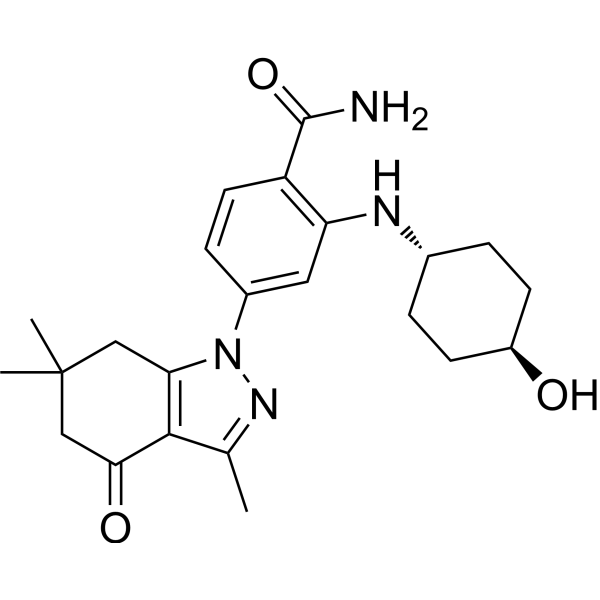Physicochemical Properties
| Molecular Formula | C23H30N4O3 |
| Molecular Weight | 410.509305477142 |
| Exact Mass | 410.231 |
| CAS # | 908112-37-8 |
| Related CAS # | 908112-37-8 |
| PubChem CID | 24820800 |
| Appearance | Off-white to light yellow solid |
| LogP | 3.3 |
| Hydrogen Bond Donor Count | 3 |
| Hydrogen Bond Acceptor Count | 5 |
| Rotatable Bond Count | 4 |
| Heavy Atom Count | 30 |
| Complexity | 661 |
| Defined Atom Stereocenter Count | 0 |
| InChi Key | FMOSGTTYAFQMSD-UHFFFAOYSA-N |
| InChi Code | InChI=1S/C23H30N4O3/c1-13-21-19(11-23(2,3)12-20(21)29)27(26-13)15-6-9-17(22(24)30)18(10-15)25-14-4-7-16(28)8-5-14/h6,9-10,14,16,25,28H,4-5,7-8,11-12H2,1-3H3,(H2,24,30) |
| Chemical Name | 2-[(4-hydroxycyclohexyl)amino]-4-(3,6,6-trimethyl-4-oxo-5,7-dihydroindazol-1-yl)benzamide |
| Synonyms | AT-533; AT533; AT 533 |
| HS Tariff Code | 2934.99.9001 |
| Storage |
Powder-20°C 3 years 4°C 2 years In solvent -80°C 6 months -20°C 1 month |
| Shipping Condition | Room temperature (This product is stable at ambient temperature for a few days during ordinary shipping and time spent in Customs) |
Biological Activity
| Targets | HSP90; HSV-1; ERK1; ERK2; NF-κB; Akt; HIF-1α; VEGF/VEGFR-2 |
| ln Vitro | Twenty ng/mL VEGF-induced tube, cell migration, and HUVEC templates are inhibited by AT-533 (0-1350 nM; 24 h or 48 h) [1]. Under hypoxic conditions, AT-533 (2 μM or 75 μM; 24 h) suppresses the coupling of HIF-1α/VEGF signaling in breast cancer cells and phosphorylates FAK, Akt/mTOR/p70S6K, and Erk1/2 [1]. AT-533 (0.5 μM; 2 h, 4 h) on chorion membrane (CAM) decreases the HSV-1-induced TNF-α, IL- Production of 1β and IL-6. AT-533 (10 nM, 50 nM; 48 h). |
| ln Vivo | AT-533 (10 mg/kg; intraperitoneal injection; once daily for 21 days) Fluorescent dye MDA-MB-231 Expression of HIF-1α/VEGF coupling signaling-related proteins in breast cancer xenograft tumor transplant model [1]. AT-533 (1, 2, 4 mg/kg; i.p.; once daily for 30 days) did not produce death, recovery, weight loss, or adverse effects in the Sprague-Dawley subacute poisoning study [ |
| Cell Assay |
Cell Viability Assay [1] Cell Types: Human Umbilical Vein Endothelial Cells (HUVEC): MCF-7 and MDA-MB-231 Tested Concentrations: 0, 5.6, 16.7, 50, 150, 450 and 1350nM Incubation Duration[2]: 12 hrs (hours), 24 hrs (hours), 48 hrs (hours) and 72 hrs (hours). Experimental Results: Cell viability was inhibited at 48 hrs (hours) with an IC50 value of 50.1 nM. Western Blot Analysis[1] Cell Types: MCF-7 cells and MDA- MB-231 Cell Tested Concentrations: 5 nM, 10 nM, 50 nM and 75 nM Incubation Duration: 24 hrs (hours) Experimental Results: Inhibition of VEGF-2, phosphorylation of Akt, mTOR, Erk1/2, FAK. |
| Animal Protocol |
Animal/Disease Models: MDA-MB-231 breast cancer xenograft male C57BL/6 mice [1] Doses: 10 mg/kg; 3]. Route of Administration: intraperitoneal (ip) injection; one time/day for 21 days. Experimental Results: The expression of HIF-1α and VEGF was Dramatically down-regulated. |
| References |
[1]. AT-533, a novel Hsp90 inhibitor, inhibits breast cancer growth and HIF-1α/VEGF/VEGFR-2-mediated angiogenesis in vitro and in vivo. Biochem Pharmacol. 2020 Feb;172:113771. [2]. AT-533, a Hsp90 inhibitor, attenuates HSV-1-induced inflammation. Biochem Pharmacol. 2019 Aug;166:82-92. [3]. Subacute toxicological evaluation of AT-533 and AT-533 gel in Sprague-Dawley rats. Exp Ther Med. 2021 Jun;21(6):632. |
Solubility Data
| Solubility (In Vitro) | DMSO: ~33.3 mg/mL (81.2 mM) |
| Solubility (In Vivo) |
Solubility in Formulation 1: ≥ 2.5 mg/mL (6.09 mM) (saturation unknown) in 10% DMSO + 40% PEG300 + 5% Tween80 + 45% Saline (add these co-solvents sequentially from left to right, and one by one), clear solution. For example, if 1 mL of working solution is to be prepared, you can add 100 μL of 25.0 mg/mL clear DMSO stock solution to 400 μL PEG300 and mix evenly; then add 50 μL Tween-80 to the above solution and mix evenly; then add 450 μL normal saline to adjust the volume to 1 mL. Preparation of saline: Dissolve 0.9 g of sodium chloride in 100 mL ddH₂ O to obtain a clear solution. Solubility in Formulation 2: ≥ 2.5 mg/mL (6.09 mM) (saturation unknown) in 10% DMSO + 90% (20% SBE-β-CD in Saline) (add these co-solvents sequentially from left to right, and one by one), clear solution. For example, if 1 mL of working solution is to be prepared, you can add 100 μL of 25.0 mg/mL clear DMSO stock solution to 900 μL of 20% SBE-β-CD physiological saline solution and mix evenly. Preparation of 20% SBE-β-CD in Saline (4°C,1 week): Dissolve 2 g SBE-β-CD in 10 mL saline to obtain a clear solution. Solubility in Formulation 3: ≥ 2.5 mg/mL (6.09 mM) (saturation unknown) in 10% DMSO + 90% Corn Oil (add these co-solvents sequentially from left to right, and one by one), clear solution. For example, if 1 mL of working solution is to be prepared, you can add 100 μL of 25.0 mg/mL clear DMSO stock solution to 900 μL of corn oil and mix evenly. (Please use freshly prepared in vivo formulations for optimal results.) |
| Preparing Stock Solutions | 1 mg | 5 mg | 10 mg | |
| 1 mM | 2.4360 mL | 12.1800 mL | 24.3599 mL | |
| 5 mM | 0.4872 mL | 2.4360 mL | 4.8720 mL | |
| 10 mM | 0.2436 mL | 1.2180 mL | 2.4360 mL |
